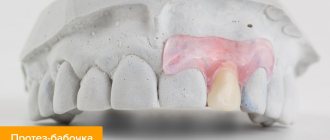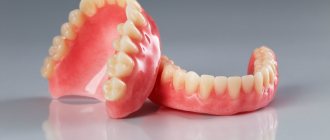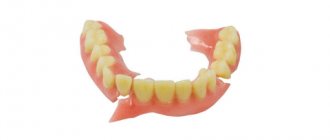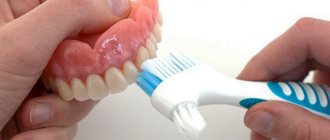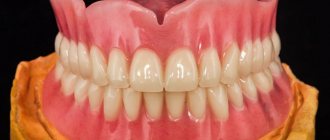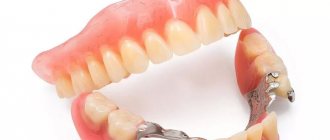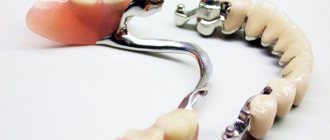General overview
Reinforcement technology is recommended for prosthetic systems made from polymer materials and is aimed at strengthening the base, which has a fine structure. The occurrence of structural defects is caused not only by excessive physical impact, but also by the natural wear and tear of the prostheses. Strength can be increased using mesh inserts made from metal or fiberglass blanks.
Placing a reinforcing frame at the base of the prosthesis provides resistance to mechanical damage. This is an optional procedure, but many experts recommend performing it at the first sign of deterioration in the properties of the prosthetic system. The presence of mesh not only strengthens the prosthesis, but also increases the comfort of wearing it.
Alternative or addition to a prosthesis
If the dentist diagnoses poor enamel quality or serious consequences of tooth decay that need to be corrected immediately, reinforcement often comes to the rescue.
This is a dental procedure that can be used to completely restore a tooth or strengthen a denture. The method is used in conjunction with the following orthodontic structures:
- temporary crowns;
- bridges;
- prostheses with multiple supports and large intermediate parts.
Reinforcement can be either an addition to prosthetics or an alternative. Depending on the situation, different parts can be used for strengthening:
- metal pins;
- grids;
- tabs;
- steel threads;
- fiberglass.
Fiberglass is the most popular, because thanks to this technology it is possible to restore a missing tooth without installing dentures. At the same time, the operation takes little time, and the price is not very expensive. True, there are certain risks. It is not recommended to heavily load a tooth restored with fiberglass, because regular chewing of hard food can lead to a change in the original appearance of the structure. In addition, this technology is only suitable for restoring one tooth (by attaching to two adjacent support elements).
Material
When choosing the material used to reinforce dentures, the following factors are taken into account:
- Biological compatibility;
- Resistance to acids and mechanical stress;
- Maximum duration of operation;
- Interaction with pathogenic microflora of the oral cavity.
In modern dentistry, aramid threads, metal-based meshes, cast alloy gaskets, and bases made of precious metals are used. Until recently, the most popular option was high-strength fiber fabric, but today preference is increasingly given to carbon fiber or aramid threads.
Reinforcement of a denture with mesh
Reinforcement of the prosthesis is the fixation of the prosthesis with metal, it increases strength.
Removable dentures are mainly made from plastic. It is not considered particularly reliable, as it soon wears out and becomes mechanically damaged. It also cracks or its base breaks. Reinforcement holds all parts of the prosthesis together if a fracture occurs. Reinforcement for a removable denture is not considered necessary. But this helps reduce the risk of failure by 10% in the first year. Protects from bending and breaking, the base becomes stronger. This makes it easier to repair if a breakdown occurs.
Indications and contraindications
When deciding to reinforce the prosthesis, you do not have to worry about possible discomfort after making changes to the structure of the structure. All reinforcing elements are located inside the base, do not come into direct contact with mucous tissues, and do not have a negative effect on the condition of the oral cavity. The indications, the presence of which is the reason for reinforcing the prosthetic system, include:
- Narrowing of the oral cavity - in such situations, the service life of the prosthesis increases many times, and its likelihood of damage is minimized;
- Prevention of possible fracture of the base of a worn prosthesis;
- Specific design of the bed, requiring reinforcement of the structure;
- The need for fixation of units of the dentition, characterized by increased mobility;
- Restoration of shrinkage density, eliminating chafing of the mucous membrane.
Limitations to the procedure are determined individually, during an examination in a clinical setting, as well as based on an analysis of the patient’s medical history.
Manufacturing and general requirements
The installation of the reinforcing mesh is carried out by a qualified dental technician, which is due to the complexity of the procedure. The whole process is divided into the following stages:
- Examination of the condition of the oral cavity and calculation of the potential load on supporting units;
- Preparation of a reinforcing mesh based on a plaster model of the jaw apparatus;
- Adjustment and installation of position limiters of the reinforcing element;
- Preliminary application of a fixing polymer composition;
- Installation of the base in the cuvette on one side of the grid;
- Applying the final layer of polymer, followed by sanding and polishing.
Installation of the reinforcing mesh is carried out only in the base, since placement in the beam part of the prosthesis does not increase the strength of the structure. It is recommended to reinforce deep areas with a pronounced relief texture. The duration of the procedure is from 7 to 10 days.
Before deciding to install a reinforced prosthetic structure, it is imperative to determine the presence of a possible allergy to acrylic or metal materials that are planned to be used to create an orthopedic product. Identifying limitations is an important condition, since otherwise the production of the system may not bring the desired result, since the patient will not be able to use the prosthesis for its intended purpose.
Advantages and disadvantages
The positive aspects of using reinforced prostheses are obvious:
- Strength and durability;
- Comfort and reliability;
- Convenient hygienic care;
- Aesthetics and functionality.
Strengthened models allow you to increase the load on the dentition without fear or negative consequences, which is important for patients in the older age group.
Among the disadvantages characteristic of the technology, there is an increase in the mass of prostheses reinforced with metal meshes, as well as the need to go through an adaptation period.
Service life
The service life of structures without reinforcement varies between 3-5 years. It can be less than these values (for fractures of the base) and higher (up to 7-8 years) if the product is used correctly in compliance with hygienic standards.
Note. When talking about the service life of a structure, most often we mean the service life, which, in addition to the quality of the product itself, also depends on the rate of atrophy of the jaw bone tissue.
In the event that the system does not break down, most often it is bone atrophy that determines the service life.
Considering that the acrylic base under favorable conditions (no atrophy and fractures) can last up to 8-10 years, the service life of a reinforced acrylic prosthesis can be considered just that - 8-10 years.
In what cases is tooth reinforcement performed?
Doctors perform reinforcement of pulpless teeth that have been severely destroyed as a result of deep caries, pulpitis, periodontitis or due to trauma. The roots and coronal area can be subjected to this manipulation. Next, a composite material is built up or artificial crowns are installed, which accurately recreate the anatomical shape, color and functionality of a natural tooth.
On a note! The procedure can be performed in cases where the patient is diagnosed with inflammation of the periodontal tissues, leading to loosening of the roots. Teeth that are loose due to periodontitis or periodontal disease are strengthened with fiberglass threads, which keep them from falling out and correctly distribute the chewing load, but here it is more correct to talk not about reinforcement, but about splinting.
If one tooth is missing, the specialist can also offer you a reinforcement procedure with special materials in order to quickly restore the defect and restore the integrity of your smile. For example, with direct restorations, doctors build up the crown with a composite on fiberglass threads fixed between two supporting adjacent teeth. This will allow the patient to solve the problem of partial adentia in one visit to the clinic.
Causes of structural fractures
Under normal operating conditions, acrylic dentures rarely break. Factors that create an increased risk of fracture can be divided into 3 groups:
- related to the properties of the material used - both the base and the reinforcement;
- due to the nature of the load on the prosthesis;
- associated with a violation of manufacturing technology or some objective conditions existing in the denture workshop.
Reasons related to the quality of acrylic polymer
- Insufficient tensile, impact and bending strength of the base material.
- Polymer aging.
- Reduction in the strength of the base due to water absorption during polymerization.
Reasons due to the nature of the load
- High values and multiple loads on the prosthesis.
- Clinical and anatomical features of the jaw and oral cavity – torus, exostoses, flat palate, narrowed jaw, single teeth.
- Complex jaw prosthetics. These are cases when the manufacture of a prosthesis is carried out after surgery due to any defect in the teeth or jaws.
Causes of breakdowns due to the manufacturing process
- Entry of foreign bodies into the polymer mass.
- Pieces of wax remaining on the surface of the teeth, leading to disruption of the surface of the mold.
- Uneven thickness of the base plate.
- Defects in dental alignment.
- Violations during installation of reinforcement.
- Error in determining the central relationship of the jaws.
- Failure to comply with the polymerization regime, leading to internal stress. For example, cooling the structure too quickly after polymerization.
- Uncorrected bony protrusions.
- Errors of the technician or doctor in ensuring correct occlusion (contact of the upper and lower teeth).
Factors that increase the risk of failure
- Bruxism (night grinding of teeth).
- The presence of a complete removable denture in the opposite row.
- Rough handling, such as falling, plunging into too hot water.
In general, to summarize, the service life of an acrylic prosthesis is based on three components: the presence of reinforcement, workmanship and proper operation.
Reviews
People experiencing a particular health problem are always interested in knowing how others cope with it.
We invite you to read reviews from patients at dental clinics who have installed reinforced acrylic dentures.
If you have your own experience using such products, share it with others and leave your review at the bottom of the page. For some, your advice may be a lifesaving option.
If you find an error, please select a piece of text and press Ctrl+Enter.
Tags denture reinforcement dentures prosthetics
Did you like the article? stay tuned
Prosthetic bridge
Veneers are now widely used in dentistry. They allow you to give the tooth the ideal shape and select the desired color, which overall brings an excellent cosmetic effect.
Veneers allow you to:
- restore various enamel effects (congenital or acquired);
- teeth darkened as a result of injury or improper root canal treatment;
- teeth yellowed after prolonged use of antibiotics (“tetracycline teeth”);
- fluorous spots on enamel;
- correct irregular tooth shape;
- get rid of chips formed on the teeth; correct the presence of gaps or gaps between the teeth;
- return old fillings to the natural color of tooth enamel;
As a rule, veneers are applied to a pre-treated tooth (their thickness is from 0.3 to 0.5 mm), which are secured with heavy-duty light-curing cement. This allows you to achieve an excellent cosmetic effect: a veneer can give the tooth an ideal shape, and the use of cements of various shades gives the desired color. Porcelain veneers are representatives of high technology in dentistry; in their production we use only imported materials. The development of technology for cosmetic dental restoration in many cases makes it possible to avoid complex and lengthy orthodontic treatment and does not require large material costs.
What are the dentures reinforced with?
The denture base is made of polymethyl methacrylate (acrylic plastic). It is made by injection molding with cold or hot polymerization. Hot polymerization increases the performance properties of the product.
Previously, plate structures were reinforced with metal. Today, polymers or other materials are also used for this purpose. This variety allows you to choose the best option for each patient.
The fittings for the prosthesis are made from the following materials:
- Metal alloys
- Cellulose fiber
- Fiberglass
- Aramid threads. Durable, wear-resistant material that is not afraid of exposure to organic solvents
- Heavy duty polyethylene. In order for polyethylene fibers to better adhere to the base of the structure, they are treated with gas-discharge plasma. After this treatment, polyethylene adheres well to resins and plastics
- Carbon fibers. Thin filaments (5-15 microns), in which carbon crystals are located parallel to each other. Because of this, they do not break even under strong tension. The advantage of carbon fibers is their chemical inertness, lightness, low coefficient of thermal expansion
- Quartz fibers. This is silicon oxide, which is characterized by elasticity, strength, good resistance to high temperatures and aggressive substances
Strengthening dentures with metals has long been used in denture practice. The most commonly used design is a mesh of thin wire, as well as perforated and cast plates. Manufacturers produce standard reinforcing elements (metal mesh and perforated plates). There are products made specifically for the sky (a plate with a hole in the middle).
The reinforcement is made of plastic fine mesh with a continuous metal edging.
Reinforcement elements are sometimes coated with gold and installed in areas of stress concentration
Some metal meshes are coated with gold plating. It increases the strength and aesthetics of the product. Gold-plated elements are well attached to the plaster model, firmly adhere to acrylic and match its color.
How long do acrylic dentures last?
Dentures without reinforcement last approximately 3 – 5 years. If you properly care for it and handle it with care, its service life increases to 7–8 years.
If used incorrectly and poorly maintained, the product may not last even the required 3 years.
However, the service life of the product depends not only on its quality, but also on the rate at which the jaw bone decreases. Even if the structure does not break, it has to be replaced due to the fact that the bone tissue decreases in volume.
Acrylic plates on which artificial teeth are attached can last a very long time (8 – 10 years) under favorable conditions.
General requirements
Before deciding to install a reinforced prosthesis, you need to find out if you are allergic to metal or acrylic. It is an allergic reaction to some component of the metal that can worsen the condition.
It is important to consider the following points before installation:
- Allergy to acrylic compounds or precious metals.
- Increased tooth wear.
- Severely loose teeth.
- Low height of supporting teeth.
- Malocclusion.
If the patient has such characteristics of the oral cavity, then strengthening the structure may be prohibited.
It is important that the material meets the following qualities:
- possibility of high-quality processing;
- biocompatibility;
- high strength;
- hypoallergenic;
- aesthetics;
- minimal shrinkage.
primary goal
Most often, plastic removable dentures are reinforced. They are made thin and during operation can be damaged by mechanical stress. Also, plastic prostheses are subject to thinning during wear, so it was decided to install a metal mesh or fiberglass for them.
Once metal is added to the structure, it becomes more resistant to stress. This option is optional and mesh installation is done only if the patient wishes. But in most cases, it is this method that becomes life-saving and extends the service life of replacement devices.
Metal is good not only because it strengthens the base of the devices, but also helps them to better stay in place. He holds the form that was betrayed from the beginning.
Prices
The prices listed below should be viewed as approximate nominal values, since the cost of prosthetics depends not only on the type of base material and the presence or absence of reinforcement, but also on the material of the teeth (imported ones are more expensive, domestic ones are cheaper).
And also the price depends on other features, for example, elements of fastening the prosthesis. The cost of a separate reinforcement operation starts from 5,000 rubles.
Approximate prices of reinforced and non-reinforced acrylic and nylon prostheses
| Type of prosthesis | unreinforced | Mesh reinforced |
| acrylic full | Up to 25,000 | From 30000 |
| acrylic partial | up to 15000 | From 25000 |
| nylon full | from 30000 | From 37000 |
| nylon partial | from 25000 | From 30000 |
Removable prosthetics
Clasp dentures
Clasp dentures are a removable dental structure that allows you to replace lost teeth. Before installing clasp dentures, the dentist checks the teeth for defects. It is important that the teeth on which clasp dentures are planned to be fixed are absolutely healthy, since in the future they will have to withstand the load.
Clasp dentures
Prosthetics on mini-implants
In conditions of insufficient bone, our dentists recommend using mini implants with a diameter of no more than 2.5 mm. This weightless design makes it easy to install, with minimal injury and subsequently makes it possible to obtain cheaper treatment and prevention.
Prosthetics on mini-implants
- partial plate dentures
- complete plate dentures
Advantages and disadvantages
When a client of a dental office decides to install a reinforced orthopedic structure, his attending physician must describe in detail all the pros and cons of such a procedure.
The absolute advantages are:
- high strength;
- durability;
- comfort;
- reliability;
- ease of cleaning;
- the ability to increase the mechanical load on the teeth;
- aesthetics.
If we talk about the disadvantages of such structures, they are as follows:
- increase in weight (when using metal mesh);
- long addiction;
- temporary change in diction;
- high thermal conductivity;
- high price for reinforcement with precious metals.
It is important that the prosthesis does not cause discomfort after installation.
Features of the classification of toothless jaws according to Oxman and other authors.
In this article we will discuss the cost of relining a removable denture.
Here https://www.vash-dentist.ru/protezirovanie/semnyie-p/zubnyie-na-prisoskah.html reviews about dentures with suction cups are offered.

